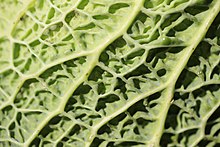Savoy cabbage
This article needs additional citations for verification. (January 2017) |
 Savoy cabbage | |
| Species | Brassica oleracea var. sabauda L. |
|---|---|
| Cultivar group | Brassica oleracea Savoy Cabbage Group |
| Cultivar group members |
|
 | |||||||||||||||||||||||||||||||||||||||||||||||||
| Nutritional value per 100 g (3.5 oz) | |||||||||||||||||||||||||||||||||||||||||||||||||
|---|---|---|---|---|---|---|---|---|---|---|---|---|---|---|---|---|---|---|---|---|---|---|---|---|---|---|---|---|---|---|---|---|---|---|---|---|---|---|---|---|---|---|---|---|---|---|---|---|---|
| Energy | 113 kJ (27 kcal) | ||||||||||||||||||||||||||||||||||||||||||||||||
6.1 g | |||||||||||||||||||||||||||||||||||||||||||||||||
| Sugars | 2.27 g | ||||||||||||||||||||||||||||||||||||||||||||||||
| Dietary fiber | 3.1 g | ||||||||||||||||||||||||||||||||||||||||||||||||
0.1 g | |||||||||||||||||||||||||||||||||||||||||||||||||
2 g | |||||||||||||||||||||||||||||||||||||||||||||||||
| |||||||||||||||||||||||||||||||||||||||||||||||||
| Other constituents | Quantity | ||||||||||||||||||||||||||||||||||||||||||||||||
| Water | 91 g | ||||||||||||||||||||||||||||||||||||||||||||||||
| †Percentages estimated using US recommendations for adults,[1] except for potassium, which is estimated based on expert recommendation from the National Academies.[2] | |||||||||||||||||||||||||||||||||||||||||||||||||
Savoy cabbage (Brassica oleracea var. sabauda L. or Brassica oleracea Savoy Cabbage Group),[3][4] is a variety of the plant species Brassica oleracea. Savoy cabbage is a winter vegetable and one of several cabbage varieties.[5]
It is thought to originate from England and the Netherlands.[citation needed] In the 18th century, it was introduced into Germany as "Savoyer Kohl".[6] It is named after the Savoy Region in France.[7] It is known as 'cavolo verza' in Italy.[7]
It has crinkled, emerald green leaves.[8] The leaves are crunchy and tender.[6]


Known cultivars include; 'Savoy King' (in the US),[6] 'Tundra' (green with a firm, round heart) and 'Winter King' (with dark crumpled leaves).[5]
Uses
'Savoy' cabbage does not turn into mush when cooked. It has the same flavor and appearance as regular cabbage when cooked but retains a firm texture which is desired in some recipes. 'Savoy' cabbage can be used in a variety of recipes. It pairs well with red wine, apples, spices, horseradish and meat.[6] It can be used for roulades, in stews and soups, such as borscht,[7] as well as roasted plain and drizzled with olive oil. It can be used in preserved recipes such as kimchi or sauerkraut,[7] and with strong and unusual seasonings such as juniper.[9]
Signs of desirable quality include cabbage that is heavy for its size with leaves that are unblemished and have a bright, fresh look. Peak season for most cabbages in the Northern Hemisphere runs from November through April.[8]
Fresh whole cabbage will keep in the refrigerator for one to six weeks depending on type and variety. Hard green, white or red cabbages will keep the longest while the looser 'Savoy' and Chinese varieties such as napa and bok choy need to be consumed more quickly. It is necessary to keep the outer leaves intact without washing when storing since moisture hastens decay.
The cabbage provides fiber, vitamins A, C, K and B6, folate, potassium, manganese, thiamin, calcium, iron and magnesium.[7]
Savoy can be difficult to grow as it suffers from caterpillars, pigeons and club root disease.[8] It does best in full sun,[4] and is winter hardy, able to tolerate the cold, frost and snow, [6][4]
See also
- January King Cabbage (another Winter cabbage)
References
- ^ United States Food and Drug Administration (2024). "Daily Value on the Nutrition and Supplement Facts Labels". FDA. Archived from the original on 2024-03-27. Retrieved 2024-03-28.
- ^ National Academies of Sciences, Engineering, and Medicine; Health and Medicine Division; Food and Nutrition Board; Committee to Review the Dietary Reference Intakes for Sodium and Potassium (2019). Oria, Maria; Harrison, Meghan; Stallings, Virginia A. (eds.). Dietary Reference Intakes for Sodium and Potassium. The National Academies Collection: Reports funded by National Institutes of Health. Washington, DC: National Academies Press (US). ISBN 978-0-309-48834-1. PMID 30844154. Archived from the original on 2024-05-09. Retrieved 2024-06-21.
- ^ "Cabbage (Red Cabbage, Savoy Cabbage, White Cabbage, Sweetheart Cabbage)". thetortoisetable.org.uk. Retrieved 23 January 2017.
- ^ a b c "Brassica oleracea Savoy Cabbage". rightplants4me.co.uk. Retrieved 23 January 2017.
- ^ a b Titmarsh, Alan (2008). The Kitchen Gardener. BBC Books. p. 247.
- ^ a b c d e "Savoy Cabbage". specialtyproduce.com. Retrieved 23 January 2017.
- ^ a b c d e Sherman, Amy (29 March 2010). "All about Savoy Cabbage". cookingwithamy.blogspot.co.uk. Retrieved 23 January 2017.
- ^ a b c Hyman, Clarissa. "Savoy cabbage In Season". foodandtravel.com. Retrieved 23 January 2017.
- ^ Henry, Diana (12 December 2010). "Savoy cabbage with juniper recipe". The Telegraph. Retrieved 23 January 2017.
External links
- Brassica oleracea var. sabauda L., Tropicos.org, Missouri Botanical Garden
![]() Media related to Brassica oleracea var. sabauda at Wikimedia Commons
Media related to Brassica oleracea var. sabauda at Wikimedia Commons

